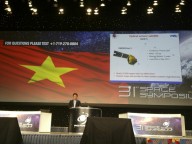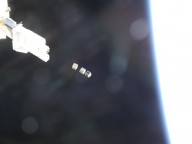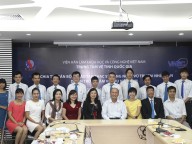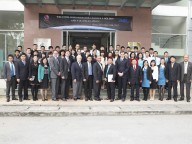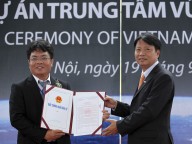SJR: We hear it said that the strategic long-range plan for the aerospace field up to 2020 was estab- lished in Vietnam. Could you introduce a general view of this plan, such as fundamental significance, situation of the establishment, overview and so on? And also please give us the progress status of the plan, such as which have been accomplished and which is to be realized in the year to come.
Dr. Pham Anh Tuan :
In order to promote research and application activities in Space Technology to serve the industrializa- tion-modernization and the sustainable social-economic development of Vietnam, since 2002 the Govern- ment has assigned Vietnam Academy of Science and Technology (VAST) to coordinate with the Ministry of Science and Technology and other related ministries and offices to define the strategy and development plan of Space Technology of Vietnam.
In June 2006, the Prime Minister has approved “The Strategy for Research and Application of Space Technology of Vietnam until 2020” which identifies objectives, contents and solutions for space technolo- gy applications until 2020 for the social-economic development of Vietnam. The overall concept of the strategy is to practically and effectively serve the tasks of social-economic development, natural resources management, environment and natural disaster monitoring as well as national security for enhancing the in- ternational status, the science – technology capability and the State power. One of the important tasks of the Strategy is that until 2020, Vietnam will be able to hold the initiative in designing, manufacturing, testing and controlling earth observation satellites in order to forecast and reduce natural disaster risk, to protect natural resources, environment and national security.
Besides, other contents of “The Strategy” are:
- Building equipment infrastructure and technology for the design, manufacture and operation of earth observation small satellite;
- Partially replacing demand of purchasing satellite images from other countries;
- Utilizing the applications of space technology to support the production, services, education, health …
- The important part of the strategy which is designing, manufacturing, testing and controlling our own earth observation small satellite has been implemented accordingly to the plan by the successful launched of VNREDSat-1 – the first observation satellite for natural resources, environment and disaster monitoring of Vietnam whose techniques has been transferred through France ODA project on May 7, 2013.
Currently, Vietnam National Satellite Center is implementing the Project of Vietnam Space Center which contains 3 main components:- Human resources development for small satellite and remote sensing technology development.
- Construction of infrastructure: Satellite control center; assembling, integration & testing facility of small satellite; management building; planetarium and education center; satellite image receiving and processing facility;
- Technology transfer: Satellite image data utilization and satellite design, manufacture, integration, testing and control of which design, manufacture and develop of 2 satellites (LOTUSat1 & LO- TUSat2) include 2 phases:
- LOTUSat1: manufacture in Japan with the participation of Vietnamese engineers.
- LOTUSat 2: designed and manufactured in parallel with the construction of satellite testing and as- sembly infrastructure. After completion, there will be on-job training in satellite integration, as- sembly and testing at Vietnam Space Center in Hoa Lac. Ground station together with satellite op- erations technology will be transferred after the launching.
Vietnam has also launched 2 communication satellites VINASAT-1(in April 2008) & VINASAT-2 (in May 2012). After trainings, Vietnamese engineers are now able to master the operation and exploitation of VINASAT communications satellites.
In order to implement next plans of the Strategy, from now until 2020, I think Vietnam should continue to carry out the following tasks:
- Based on technical infrastructure of Vietnam Space Center and other projects, Vietnam should fo- cus on research that improve the efficiency of telecommunication applications, remote sensing, ge- ographic information system (GIS) and the global navigation system to support the social- economic development, natural resources, disaster and environment monitoring, global climate change and sea level rise impact assessment.
- Gradually master the design, manufacture, assembly of small earth observation satellites.
- Preparing facilities for capacity development, which is the fundamental for the sustainable devel- opment of Space Science and Technology of Vietnam.
Dr. Pham Anh Tuan, you are the director of Vietnam National Satellite Center (VNSC). Could you explain the relationship between the long-range plan and the establishment of VNSC and the role of VNSC?
Being aware the importance of “The Strategy for Research and Applications of Space Technology of Vietnam until 2020” approved in June 2006, in 2007, VAST has proposed the construction of Vietnam Space Center at Hoa Lac Hi-Tech Park. After the preparation phase, VAST has been appointed by the Gov- ernment to receive and implement Vietnam Space Center Project at Hoa Lac with the support from Japan in design and construction.
On April 22th 2009, the Prime Minister concluded: “This is a key investment project, creating the core basis for the implementation of space technology research and development, education, applications and international cooperation in Space technology, to implement the strategy of research and applications of Space technology until 2020.” On the basis of Vietnam Space Center Project and in order to implement this Strategy and beyond, in May 2010, VAST has planned to establish the Vietnam National Satellite Center. One of the tasks of Vietnam National Satellite Center is to receive, manage and implement Vietnam Space Center Project.
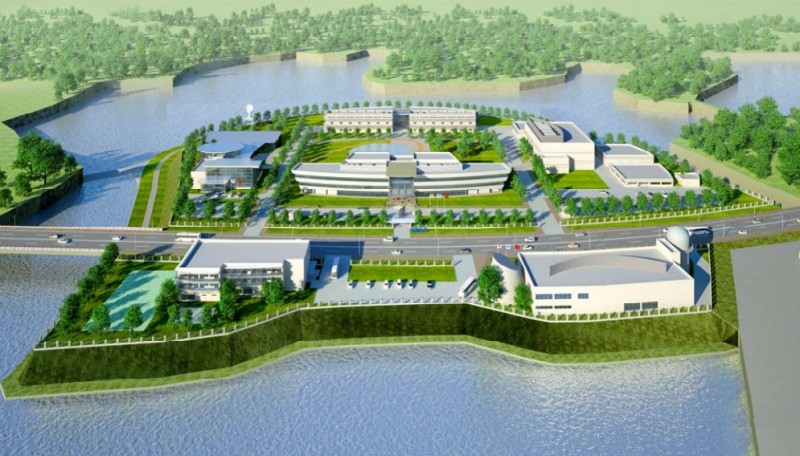
On September 16th 2011, the Vietnam National Satellite Center, belonging to VAST, was established under a decision of the Prime Minister of Vietnam. In November 2011, the Government of Vietnam and Ja- pan signed ODA loan agreement for the Vietnam Space Center Project.
Vietnam Space Center Project has the investment of about 54 billion yen from ODA loan of Govern- ment of Japan and counterpart funding from the Government of Vietnam. This project is particularly im- portant in the scope of “The Strategy for Research and Applications of Space Technology of Vietnam until 2020” which is implemented by VNSC.
Vietnam Space Center is in charge of the important task: Mastering the technology of small earth obser- vation satellite, be able to observe the whole territory of Vietnam in any weather conditions with modern radar technology. The Center will be intensively and comprehensively invested aiming to the ability to self- design and manufacture satellites. Once we can manufacture our own satellites, we can be more proactive in utilizing satellite images on social – economic development and other fields.
The second goal of the Center is to develop and process satellite data for natural disaster monitoring and early warning, early forecasting of agricultural products, marine resources, updating digital mapping sys-tem for land management and planning, global climate change research and adaptation. If we have our own source of satellite images, we will surely be able to decrease the damage of natural disasters.
The third objective of the project is to develop a professional and know-how workforce. VNSC will send about 100 engineers and managers to Japan to participate in training courses in Satellite Technology, Satel- lite Technology Applications, and Management and Operation of Vietnam Space Center.
Could you introduce yourself related with the aerospace field? What is your policy and strategy for the establishment of aerospace technology in Vietnam?
Immediately after the Prime Minister approved the Strategy, I have been involved as the Vice Director of Space Technology Institute, managing a group of young researchers to start doing research, designing and manufacturing small satellites.
With my position and based on studying experiences in developing Space Technology of developed countries such as Japan, United States, Europe, Russia, India…, I had proposed the idea of developing Vi- etnam Space Center with the purpose of building a solid foundation with 3 main components (human re- source, infrastructure and technology) in order to develop Space Technology of Vietnam permanently and sustainably with a focus on human resource development.
Also for the purpose of developing human resource for Space Technology in Vietnam, I have been in- volved in the Engineer and Master training courses in Space Technology at College of Technology, Vietnam National University – Hanoi (ColTech – VNU, Hanoi) and University of Science and Technology of Hanoi (USTH) in Vietnam.
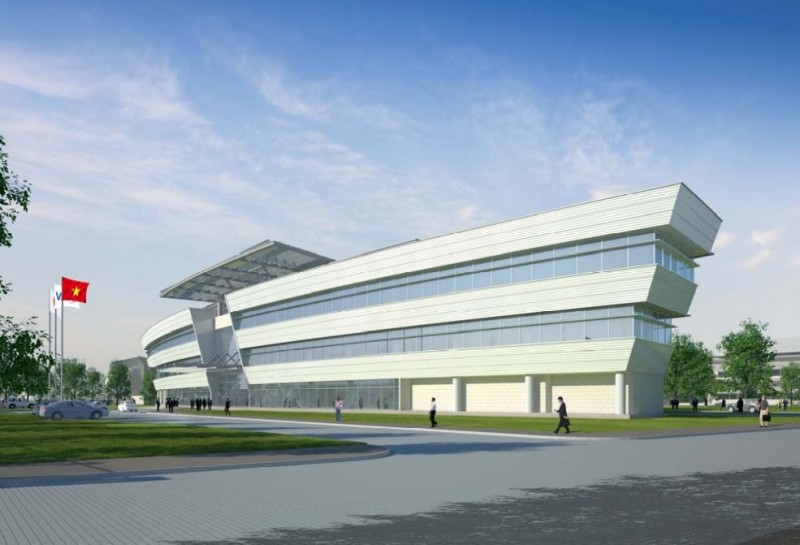
Then, please explain more details of VNSC such as scale, overall structure, tasks, activities, interna- tional cooperation, launch & operation plan, and so on.
Vietnam Space Center is built in at Hoa Lac Hi-tech Park in Hanoi, including multiple functional facili- ties such as the Space Technology Control Center; Assembly, Integration and Testing Center (AIT); Man- agement Building, Planetarium, R&D and Education Center; ground station to transfer and receive data from satellites. Upon completion, Vietnam Space Center will be a center for research and manufacture of small satellites for the demands of weather forecasting, monitoring, exploration, radio and television broad- casting, search and rescue, climate change and natural disaster impact mitigation, natural resource manage- ment and environment monitoring. In recent years, Vietnam has deployed data from these centers for re- search and contributes to evaluate proposed solutions to climate change adaptation and environmental pol- lution.
As in the plan, in 2016, the Vietnam Space Center will complete the basic construction part to prepare equipment and technologies for launching the first satellite LOTUSat-1 in 2017. This satellite will be de- signed, manufactured and assembled in Japan.
Upon completion of Vietnam Space Center Project in 2020, Vietnam will have the most modern R&D and Education center in Space Technology in Southeast Asia; and towards 2020, Vietnam will master the manufacture of small earth observation satellites.
Vietnam has a long north-to-south coastline with multiple regions with different climatic and geograph- ical conditions. Thus, Vietnam is one of the most disaster-affected countries in the world. Losses from dis- asters are approximately 1.5% of Vietnam’s GDP, together with hundreds of deaths annually. Therefore, disaster monitoring is an indispensable task. Effective utilization of data from earth observation satellites will significantly contribute to reducing disaster loss and damages. Specifically, being active in satellite im- ages, we would regularly update storm and flood conditions so that we would have timely and effective warning to protect people’s lives and properties, reducing cost for search and rescue… Utilization of satel- lite data can also clearly identify locations of deforestation, forest fire for timely solutions. Similarly, satel- lites can trace pollution caused by industrial waste and oil spills. Besides, satellite and satellite technology applications can monitor erosion, landslides, earthquake, sea level rise and the effects of climate change… Satellites with radar sensor can take pictures in cloudy, bad weather conditions, so the usage frequency and efficiency can increase dramatically.
Vietnam and Japan have different starting points in developing Space Technology. From the starting point, Japan already had a modern and advanced industry, while Vietnam is still a developing country, cur- rently focusing on infrastructure development and the industry mainly at the stage of processing and as- sembly.
In 2006, after the Prime Minister approved the Strategy for Space Technology, we have proposed an idea of building Vietnam’s own Space Center. Based on this thought, we have gradually improved the idea and discussed with foreign partners. Coincidently this is also the time Japan were enhancing the coopera- tion with Vietnam in the field of science and technology, concentrated at Hoa Lac High-Tech Park.
There are only few countries/territories in the world that are able to transfer space technology namely the United States, Russia, Europe, Japan, China and India. Japan is Vietnam’s strategic partner. Both coun- tries are being heavily affected by natural disasters, climate change and sea level rise. Therefore, Vietnam and Japan can easily find a common understanding. Besides, Japan has strong financial resource and has actively supported the development of Vietnam.
The Vietnam Space Center Project is an important milestone in the investment of ODA Projects for both Vietnam and Japan.
Human resource development will be a major challenge in response to expand the space development and utilization based on the long-range plan in Vietnam. Could you tell us what you think in this re- gard and how do you promote this program?
In my opinion, capacity development is the most important strategic task to the development of Space Technology of Vietnam.
As the leader of VNSC, I am really concerned about developing a qualified workforce for VNSC be- cause this will be the main workforce of Space Technology of Vietnam in the future. Currently 60% of VNSC staff members are under the age of 30. VNSC has made short term and long term training plan: 18 staff were sent to a short term course in project management; in the next three years, 54 engineers will be
sent to trainings and receiving satellite technology transfer, of which 36 staff will participate in Master’s
course in five universities in Japan. Besides, other 40 members will be sent to attend satellite technology applications courses. After the training program, this workforce will have the opportunities to work at space centers, companies to practice designing, integrating, testing satellites and satellite technology appli- cations.
Along with sending qualified staff to study abroad (Japan, Europe etc..), VNSC has signed the MOU with University of Science and Technology of Hanoi for graduate study in Space Technology; collaborated with College of Technology (Vietnam National University, Hanoi) to design engineer programs in Space Technology in: design and manufacture of space equipment, operate ground stations, space technology ap- plications, space techniques, space propulsion devices …
For long-term development, under the leadership of Vietnamese Government, in the coming years, VAST will develop a training program for capacity development in the field of Space Technology to sub- mit for approval of the Government.
Could you tell us your long term expectation for Japan in space cooperation?
Vietnam and Japan have defined each other as strategic partners, therefore I hope cooperation in Space Technology will be a symbol/highlight and increasingly promote the strategic cooperation between the two countries to a new level.
Through the Project, the people of Vietnam and Japan will be more connected to create the power for long-term collaboration.
During past years, VNSC people have been cooperating with people in Japanese government and in Japanese manufacture for your project implementation. How do you observe the difference and simi- larity between your country and Japan in terms of culture, working style in general?
The first thing I realize is that the pronunciation of the word “space” in Vietnamese “VU TRU” and in Japanese “USHU” is quite similar. Vietnamese and Japanese culture have many things in common, for in- stance, people eat rice, use chopsticks, very friendly and work hard.
Japanese people have a very thoughtful and careful working attitude, especially they are always on time, which VNSC young members should learn. During the training periods in Japan, I expect that beside the academic study, Vietnamese engineers would learn the discipline and careful working style and the professional teamwork ability from Japanese colleagues.
VNSC young students are the first group of Vietnamese engineers that are regularly trained in Space Technology. They will be the important connection for long-term cooperation between Vietnam and Japan in the field of Space Technology.
Lastly, may I ask how do you enjoy private life away from work?
The first thing I like is doing “worthy” work for my country.
Besides, I love travelling around the world to get to know the countries, cultures, people and hope to learn good things.
We hope you will continue to cooperate with us in the space development and utilization. Thank you very much for taking the time to talk with us today.
Thank you very much.
Biography PHẠM ANH TUẤN
Vietnam National Satellite Center (VNSC) – Vietnam Academy of Science and Technology (VAST)
18 Hoang Quoc Viet Road, Cau Giay District, Hanoi, Vietnam.
Phone: + 84-4-37915106; Email: patuan@vnsc.org.vnPham Anh Tuan received Dipl.-Ing. in 1984 at Ilmenau University of Technology, Ger- many where he also received Dr.-Ing. in 1986. In 1987, Dr. Tuan joined Vietnam Acade- my of Science and Technology and was the Vice Director of Space Technology Institute
from 2007 to 2010. In 2011, Dr. Tuan was appointed Director of Vietnam National Satellite Center and. In addition, he served as Chairman of Project Management Unit of Vietnam Space Center Project, as Co-Dean of the Space and Application Faculty of University of Science and Technology of Hanoi, as Secretary Gen- eral of Vietnam Mechatronics Association. Pham Anh Tuan is Associate Professor at VAST, he has accom- plished many researches and publications on simulating, designing, manufacturing robot and small satellite and more since 1987 up to date. He received the Certificate of Merit of Vietnam Academy of Science and Technology (2005 and 2012) and since August, 2010 Corresponding Member of International Academy of Astronautics (IAA).

